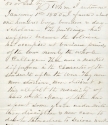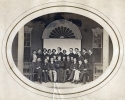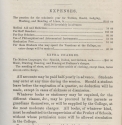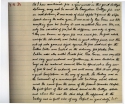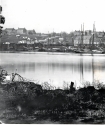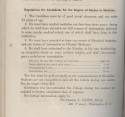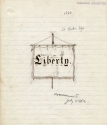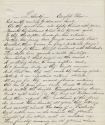In 2016, the Georgetown University Archives marks the 200th anniversary of its founding. As part of the celebration of this anniversary, a series of four exhibits will be presented online. These exhibits will look at Georgetown at 50 year intervals, starting in 1816, the year the Archives was established. Drawing upon records which the Archives preserves and makes available for use, the four exhibits as a whole will trace the growth of Georgetown as a school and as a campus between 1816 and 1966.
This is the second in the series of four online exhibits. It examines aspects of Georgetown in 1866, including the composition of the faculty and the student body, academic life, the appearance of campus, and recreational activities of students. It also touches upon some of the changes soon to be made by Patrick F. Healy, S.J., who arrived on campus in 1866 - changes so profound that he is sometimes referred to as Georgetown's second founder.
In 1866, Georgetown was in many ways regaining its equilibrium after weathering the Civil War during which enrollment dropped to as low as seventeen students and campus was occupied three times. However, the school was also on the verge of a period of significant transition and growth engineered by Patrick F. Healy, S.J., who arrived to join the faculty in 1866. By 1868, Father Healy was Prefect of Studies (Dean of the College) and in 1874 he was appointed President. During his tenure, he profoundly changed Georgetown's curriculum, physical plant, and organization of professional departments.
Bernard Maguire, S.J., President of Georgetown 1853-1858 and 1866-1870
Bernard Maguire was born in County Longford, Ireland, in 1818 and died in Philadelphia in 1886. He was twice President of Georgetown, from 1853-1858 and again from 1866-1870. During his first term, Maguire Hall was constructed and during his second, the Law Department of Georgetown College was established.
Notes of Bernard Maguire, S.J., Georgetown President from 1853-1858 and 1866-1870, with comments on the demeanor of post-Civil War students (Bernard A. Maguire, S.J. Papers)
. . . When I returned January 1st 1866, I found about one hundred boys, boarders & day scholars. The buildings had suffered because the soldiers had occupied at various periods of the war nearly the whole College. There was a marked difference in the character of the students after the war. They were more studious, more obedient & they all felt the necessity of hard work. Many of them spent some years under military discipline & now came to devote themselves to serious work . . .
Georgetown had come close to closing during the Civil War. Campus was occupied three times. In May and June 1861, Union troops were billeted here for brief periods and between August 31, 1862, and February 1863, all of the buildings on campus, except Old North, were requisitioned for hospital accommodation.
Sodality of the Blessed Virgin Mary of Georgetown College, ca. 1866
The 1865-1866 catalog notes that the Sodality is a Religious Society, placed under the patronage of the Blessed Virgin, having for its object the cultivation of virtue and piety.
Postbellum students seem to have exhibited a more religious sensibility than their antebellum equivalents and large numbers of them joined the Sodality. This replaced the debating societies as the most popular organization on campus. Students from the South were particularly prominent in the Sodality's membership.
Expenses for 1865-1866. As printed in the Catalogue of the Officers and Students of Georgetown College, District of Columbia, for the Academic Year 1865-1866
During the Civil War, the College’s income decreased sharply. Most students left and several of those who remained were stranded on campus, cut off from their families and the means to pay their fees. In 1863, a combination of reduced income and inflation forced a fee increase, the first in forty years, from $200 per year to $325. After the War, fees did not return to their antebellum levels.
Course of Studies for 1865-1866. As printed in the Catalogue of the Officers and Students of Georgetown College, District of Columbia, for the Academic Year 1865-1866
The complete course of studies was seven years: three in the Preparatory Schools and four in the Senior Classes (or collegiate division). The curriculum emphasized Greek, Latin, and mathematics. Scientific disciplines such as chemistry and astronomy were also taught but their study was limited mainly to the senior class (the Class of Philosophy) until the arrival of Patrick F. Healy, S.J., in 1866. Father Healy, as Dean of the College, added science classes for sophomores and juniors in response to requests from students and parents. He also placed more emphasis the study of English rather than Greek or Latin literature.
Statistics on the student body. As printed in the Catalogue of the Officers and Students of Georgetown College, District of Columbia, for the Academic Year 1865-1866
Students in 1866 included Thomas Stack, left, and Francis A. Barnum, right
Thomas H. Stack (enrolled 1866–1868) of Covington, Virginia, served in the Confederate army during the Civil War. He attended Georgetown after the War and joined the Jesuit order in 1868. He taught at Georgetown, as well as other Jesuit colleges, and went on to become the sixth president of Boston College.
Francis Barnum (enrolled 1866–1872) was born into a well-known Baltimore family in 1849. His father owned Barnum’s Hotel, one of the great hostelries of the South. He joined the Society of Jesus in 1880 and spent most of the 1890s in Alaska engaged in mission work. In 1898, he returned to campus as Librarian of Riggs Library. Discovering important historical documents with significant research value scattered in closets and attics across the University, he decided to gather them together for safekeeping, becoming the first University Archivist in fact, if not in name. He officially served as Archivist from 1913 until his death in 1921.
Description of the College pie from Francis A. Barnum, S.J.’s memoirs, Student Life at Georgetown in the Late [Eighteen] Sixties
Father Barnum's memoirs of his student days are among the most vivid surviving accounts of daily life on Georgetown’s campus after the Civil War.
Section 42 Pie
As I have mentioned pie a few words on this great College delicacy may not be amiss. The Georgetown College pie was an institution, it was made of dried apples & formed the staple dessert during the entire year. It was made by Bro. [Thomas] Gavan and like everything from his bakery it was excellent. There were two, and only two varieties of pie, but the difference was only in form & they were known as square pie and round pie. The first which was for the students, was baked in great oblong pans, and then cut up into generous sized squares. The pies destined for the Fathers table were baked in the ordinary pie plates. These latter were also called Priests pies. Br. Gavan was very stout and very good natured and furthermore he never looked on the boys as his natural enemies. When he spread out a long row of pies to cool he certainly was aware that it was placing a great temptation in the way of youth . . . . [Father Barnum continues on the following page that] . . . Brother Gavan never raised any howl over a [student] raid. The good old man rather enjoyed it and I think he used to make two or three extra pies just for that purpose . . .
College bake house and store with Brother Gavan seated to the left, ca. 1889
The College bake house was housed in the basement of a building that stood near the southwest corner of Dahlgren Chapel from 1814 until 1908. Above it were the College store and the shoemaking shop. From about 1856 until 1895, Brother Thomas Gavan was the Georgetown College baker.
Brother Thomas Gavan’s bread recipe
-Proportions-
-To a barrel of flour, a gallon of yeast. Take a bucket of potatoes, boil them skins and all, -when well boiled turn them into a tub, pour over them 4 lbs of flour; then smash them up-
Then take 3 gallons of lukewarm water and pour the water over the smash.
Take three gallons more of cold water & mix them all well.
Over this pour the gallon of yeast; mix well ; and leave in a tub of double capacity for the space of from 12 to 13 hours.- It ripens thus.
Then strain it well through a tin strainer
-pour 2 gallons of 1. w. [lukewarm water] over the skins -mix
& with it make the sponge, as above.
-To make yeast-
1 oz of hops & 1 oz of malt for a gallon of water.
1) Take a gallon of water & when it begins to boil put one ounce of hops - Let boil ½ hr -
2) Take 4 oz of flour & mix with it the juice of the hops until made into a dough - then pour the rest of it -
3) Take one ounce of malt & put it into a pint of cold water - & then pour it over the juice of the hops.
4) Let cool until lukewarm - Put a quart of stock yeast into it - mix well & let ferment 24 hours - Strain & use.
Faculty listing for 1866-1867. As printed in the Catalogue of the Officers and Students of Georgetown College, District of Columbia, for the Academic Year 1866-1867
Patrick F. Healy, S.J., ca. 1873. Photograph by Julius Ulke
Fr. Healy arrived at Georgetown in 1866. He became Prefect of Studies (Dean of the College) in 1868, acting President in 1873, and President in 1874. One of the University's most dynamic presidents and often referred to as Georgetown's second founder, he is credited with changing Georgetown from a small liberal arts college into a modern university. He expanded the curriculum and brought the professional departments (Law and Medicine), which were housed off-campus, more firmly under the control of the University. He also transformed campus by constructing a large new building, later named for him, which more than doubled the total square footage of Georgetown's buildings.
Patrick Healy was the son of Michael Morris Healy, an Irish immigrant who settled in Macon, Georgia, and his common-law wife, Eliza, who was an enslaved woman. He is recognized as the first African-American to enter the Jesuit Order, the first to earn a Ph.D., and the first to head a predominantly white university in the United States. However, neither the Jesuit Order nor Father Healy acknowledged his racial heritage during his lifetime.
Georgetown waterfront in 1865. Photograph by William Smith
The campus buildings seen in this image are from left to right: Gervase Hall which opened in 1831 as the College infirmary; Mulledy Hall (now known as Freedom Hall) completed in 1833, which housed the student dining hall, the student chapel and an auditorium; the South Building begun in 1788; Maguire Hall or the small boys building, completed to 1854 to house the younger students of the preparatory division; and the North Building begun in 1794.
As this image shows, buildings on campus were initially constructed on an axis facing the Potomac River. This did not change until 1877 when the foundations for Healy Hall were dug. Healy Hall would provide space for science laboratories and a larger library (Riggs Library), both of which were needed to support President's Healy curricular reforms. The building was also designed with private dorm rooms that were available to older students for an added fee. Prior to the building's completion, all students slept in open, communal dorms. The lack of private rooms had long been a bone of contention among students; some even left citing the sleeping arrangements as the reason.
Campus as seen from the Observatory, 1866 or earlier
Seen to the left is the North Building and to the right Maguire Hall, the South Building, Mulledy Hall (now known as Freedom Hall), and Gervase Hall. All but one of these buildings still stand - the exception being the South Building which was razed in 1904 to make way for Ryan Hall.
This photograph can be dated because of the height of the towers on the North Building. In 1866, a new roof was put on the building and the towers were remodeled and built up an additional 30 feet.
Library in Old North
Until 1891 and the opening of Riggs Library in Healy Hall, the College library was in Old North. A visitor in the 1880s described the Old North library as a spot of darkness and dust – a tangled garden where one came upon a treasure unexpectedly among clumps of weeds and enjoyed it all the more.
Regulations for Candidates for the Degree of Doctor of Medicine. As printed in the Catalogue of the Officers and Students of Georgetown College, District of Columbia, for the Academic Year 1866-1867
1. The candidate must be of good moral character, and not under 21 years of age.
2. He must have studied medicine not less than three years; during which he shall have attended two full courses of instruction delivered in some regular medical school, one of which shall have been in this institution . . .
Before the administration of Patrick Healy, the Medical Department and the Law Department (which opened in 1870) operated very independently from the College. Both were housed off-campus and were set up to be self-financing. Under this arrangement, faculty members shared the revenues from tuition and also bore the costs of operating the school. President Healy insisted that academic standards be raised in both Departments, lengthening their programs and mandating that written examinations be administered, as opposed to oral or no examinations.
Program from the Georgetown College commencement, July 3, 1866
Degrees were awarded to five undergraduate and seven graduate students, including one from Ireland. The length of the ceremony, 9 a.m.-3 p.m., was added at the bottom in a later, unknown hand. Most of the time was occupied by music and by the reading of poems and speeches by students. One of the students listed on the program, Robert M. Douglas, the son of Stephen A. Douglas, later served on the North Carolina Supreme Court.
Note that while the names of the student speakers are listed on the program, the names of the graduates are not.
Cover and the first of six pages of an original poem by D. Clinton Lyles read at commencement, July 3, 1866
Mention in the House Diary of a baseball game played on October 22, 1866
22 . . . Boys had holliday [sic] in the evening to go to a base-ball match . . .
While very little detail is provided, this reference appears to be the earliest one in the University Archives to the playing of baseball by Georgetown students. R. Emmett Curran notes in his History of Georgetown that: Although the sport [baseball] was played in both Northern and Southern cities well before 1861, the Civil War may have inadvertently made baseball truly the national past-time since it was much played in Northern and Southern military camps alike throughout the conflict. After the Civil War, baseball clubs were formed across the country. Many colleges established teams, Georgetown among them.
The George Washington University Archives include an account in a diary kept by student George Coffin of a slightly earlier baseball game, played against Georgetown on June 5, 1866. According to the diary: The Georgetown nine made, in the 9 innings, 24 runs to 9, made by our boys.
Program from the St. Cecilia’s Day celebration, November 22, 1866
St. Cecilia is the patron saint of musicians and church music. The College choir formed the St. Cecilia Society in the 1850s and held their annual celebration on St. Cecilia’s Day (November 22), performing in the refectory.
Handbill for Pizarro performed by the Dramatic Association on April 10, 1866
In 1853, a dramatic troupe was officially established on campus. No tickets were printed for the Association's early productions; plays were seen by invitation only and an Invitation Committee compiled guest lists and sent out invitations.
Curated by Lynn Conway, University Archivist


